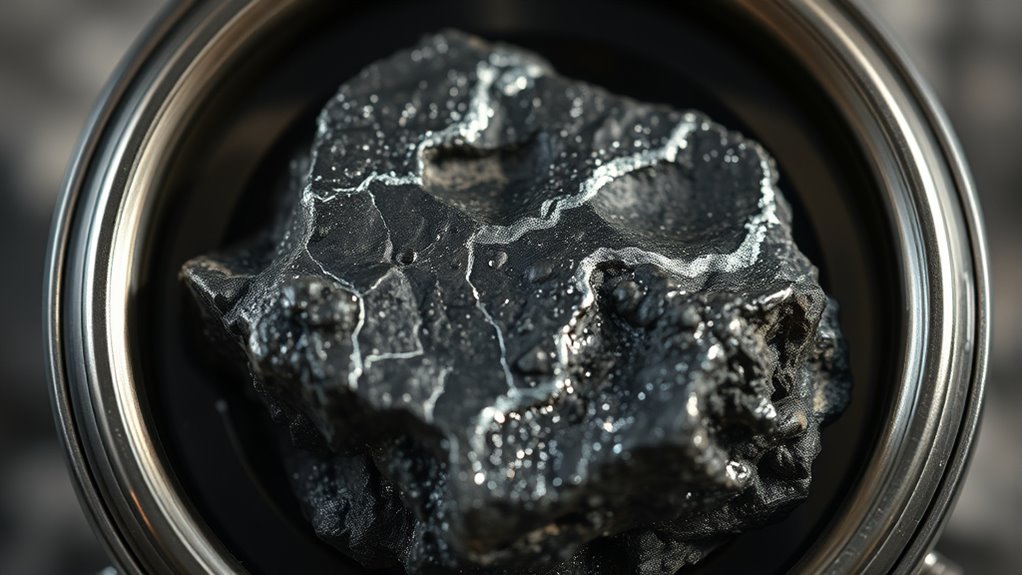NASA’s asteroid sample contains organic molecules like amino acids, which are key building blocks of life. These molecules show that life’s ingredients can form in space and survive harsh conditions during long journeys to Earth. This discovery suggests that some elements of life may have come from space, helping explain how life began here. Keep exploring to find out how this finding fits into the larger story of our origins.
Key Takeaways
- NASA’s asteroid sample contains organic molecules like amino acids, indicating extraterrestrial contributions to life’s building blocks.
- These molecules survived space conditions and could have been delivered intact to Earth’s surface.
- The findings support theories that cosmic ingredients played a role in the origin of life on Earth.
- The presence of organic compounds in space highlights the interconnectedness of cosmic chemistry and biological evolution.
- This discovery provides crucial clues about how life may have begun through a combination of space and terrestrial processes.

Could this tiny asteroid hold the key to understanding the origins of life on Earth? That’s what scientists are wondering now that NASA’s latest sample return mission has revealed. When you examine the asteroid’s collected material, it’s like opening a window into prehistoric chemistry — a time when the building blocks of life were just starting to form. The presence of organic molecules, including amino acids and other compounds, suggests that this asteroid carried cosmic ingredients that may have contributed to the emergence of life on our planet.
These organic molecules are essential clues because they’re the fundamental components of life as we know it. They didn’t develop on Earth alone; instead, many of these compounds likely arrived here from space, delivered by asteroids and comets over billions of years. This idea isn’t new, but seeing such clear evidence in this recent sample makes it more compelling. It’s like finding a piece of a puzzle that’s been missing for decades, hinting that the seeds of life might have come from beyond our planet. The asteroid’s organic content supports the hypothesis that early Earth was seeded with cosmic ingredients, setting the stage for life’s complex chemistry to unfold.
Organic molecules from space may have seeded Earth’s early life, offering clues to our cosmic origins.
As you look deeper into the sample, you realize that this tiny space rock offers a snapshot of the prehistoric chemistry that was happening long before humans ever existed. These molecules have survived the harsh environment of space, traveling millions of miles and enduring cosmic radiation. Their resilience hints at how easily these compounds could have been preserved and delivered to Earth’s surface. Once here, they may have interacted with other elements and molecules, sparking the chemical reactions that led to living organisms.
This discovery also fuels the ongoing debate about how life originated. Did it happen spontaneously on Earth through purely terrestrial chemistry? Or was it partly kickstarted by these cosmic ingredients brought in by asteroids? The answer might be a mix of both, and this asteroid sample provides concrete evidence that supports the latter. You can see how understanding the composition of these space-borne molecules helps piece together the puzzle of life’s beginnings. It’s a thrilling glimpse into the interconnectedness of the cosmos and our own origins, showing that even tiny objects like asteroids could hold the secrets to humanity’s earliest steps on Earth. Additionally, the stability of these molecules indicates that extraterrestrial organic compounds can survive the journey through space and atmospheric entry, emphasizing their potential role in seeding life on planets.
Frequently Asked Questions
How Do Organic Molecules Survive Asteroid Impact?
You might wonder how organic molecules survive asteroid impacts. Their impact resilience comes from molecular stability, which helps them withstand extreme conditions. These molecules are often embedded within protective mineral matrices or shielded by icy coatings, reducing damage during impact. This resilience allows some organic compounds to survive the intense heat and pressure, making it possible for them to reach Earth intact and offering clues to life’s origins in our solar system.
Can These Molecules Directly Lead to Life on Earth?
You wonder if these organic molecules directly lead to life on Earth. In the origins debate, scientists believe they could be initial building blocks, influencing planetary evolution. While these molecules alone might not spark life, they provide vital clues about how life’s building blocks arrived here. You should consider that their presence supports the idea that organic compounds from space contributed to Earth’s early development of life.
What Methods Detect Organic Compounds in Space Samples?
Detecting organic compounds in space samples is like unraveling a cosmic detective story. You use spectroscopic techniques, which analyze light absorption or emission to identify molecules. During sample analysis, scientists employ tools like mass spectrometers and chromatography to break down the samples and reveal their chemical makeup. These methods help you piece together the universe’s organic puzzle, shedding light on the building blocks of life scattered across space.
Are Similar Organic Molecules Found on Other Celestial Bodies?
You might wonder if similar organic molecules appear on other celestial bodies. Interstellar chemistry shows that complex organics are common throughout space, and planets like Mars or moons like Europa could host these molecules. Detecting planetary biosignatures helps confirm life’s potential. So, yes, scientists have found organic compounds elsewhere, revealing a universe teeming with complex chemistry that could support life, making the search for extraterrestrial life even more exciting.
How Will This Discovery Influence Future Space Missions?
Imagine gazing at a cosmic puzzle, where each piece reveals secrets of our origins. This discovery of organic molecules in asteroid composition will steer future space missions toward advanced spacecraft technology, designed to better analyze and collect samples. You’ll see missions become more precise, targeting asteroids with specific compositions, revealing answers about life’s building blocks. This breakthrough fuels your curiosity and drives innovation in exploring the universe’s mysteries.
Conclusion
As you reflect on this discovery, it’s like uncovering a gentle whisper from the universe, hinting at life’s delicate beginnings. These organic molecules from the asteroid softly suggest that the seeds of life might have traveled across space, quietly nudging Earth’s story forward. Though mysteries remain, this glimpse invites you to contemplate that perhaps, in the grand cosmic dance, life’s story is intertwined with the universe’s subtle, unseen threads—waiting patiently to be fully understood.









